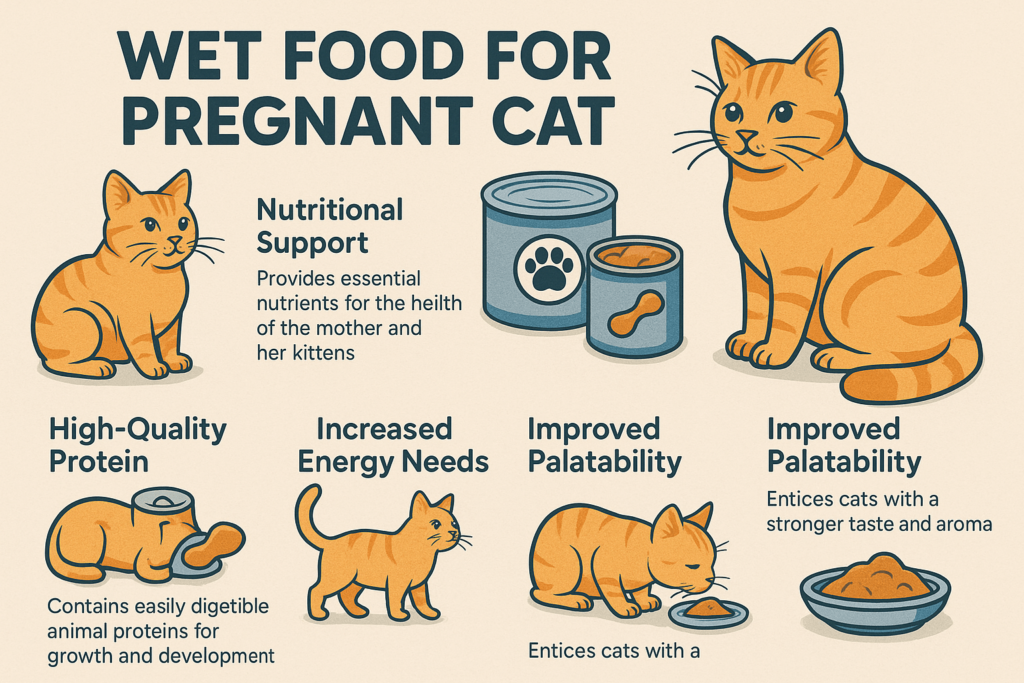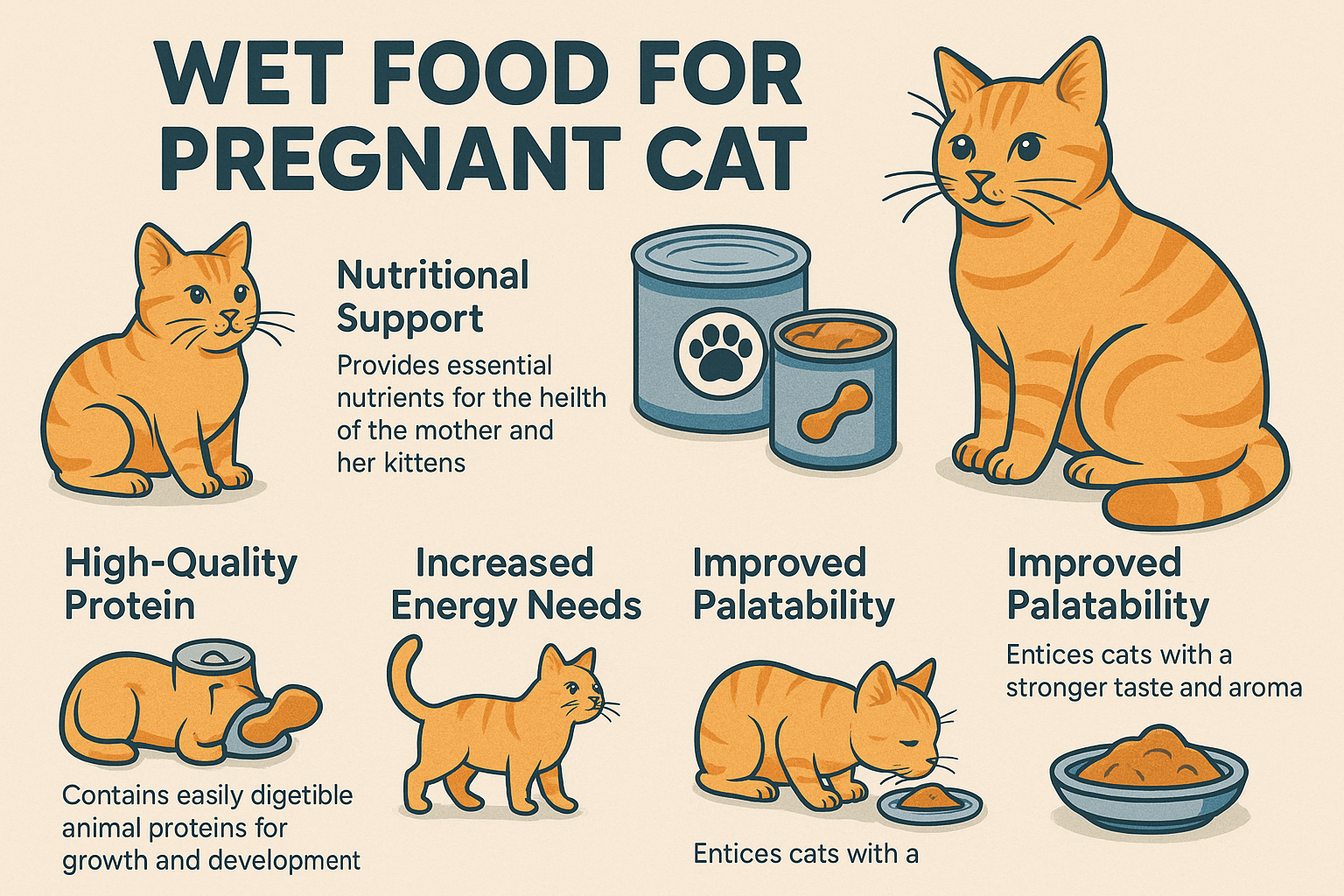Wet Food for Pregnant Cats: A Guide to Proper Nutrition
Pregnancy is a critical time for cats, and proper nutrition plays a vital role in ensuring the health of both the mother and her developing kittens. Wet food, with its high moisture content and nutrient density, is often recommended as part of a pregnant cat’s diet. But what makes wet food so beneficial, and how can you choose the best options for your feline friend? This guide explores the importance of wet food for pregnant cats, offering practical advice on feeding schedules, portion sizes, and nutritional needs. By understanding these essentials, you can provide your cat with the care she needs during this special phase of life.
Benefits of Wet Food for Pregnant Cats
Wet food offers numerous advantages for pregnant cats, making it an excellent choice to support their increased nutritional demands. Here are some key benefits that highlight why wet food should be part of their diet.
High Moisture Content:
Wet food contains up to 70-80% water, helping to keep your cat hydrated—a crucial factor during pregnancy when hydration needs increase.Rich in Protein:
High-quality wet food is packed with animal-based proteins, essential for fetal development and maintaining the mother’s muscle mass.Easier to Digest:
The soft texture of wet food is gentle on the stomach, making it ideal for pregnant cats who may experience digestive sensitivity.Lower Carbohydrate Content:
Unlike dry kibble, wet food typically has fewer carbohydrates, aligning better with a cat’s natural carnivorous diet.Enhanced Palatability:
Many cats find wet food more appealing due to its aroma and texture, encouraging them to eat even if they’re experiencing appetite changes.
These benefits make wet food a nutritious and practical option for meeting the unique dietary needs of pregnant cats.

Key Nutrients to Look for in Wet Food for Pregnant Cats
When selecting wet food for your pregnant cat, it’s important to focus on nutrient-rich options that support her health and the growth of her kittens. Here are the essential nutrients to prioritize.
Taurine:
This amino acid is crucial for fetal brain and eye development, as well as maintaining the mother’s heart health.Omega-3 Fatty Acids:
Found in fish-based recipes, omega-3s promote healthy neural development in kittens and support the mother’s coat condition.Calcium and Phosphorus:
These minerals are vital for strong bone development in growing kittens and preventing calcium depletion in the mother.Vitamins A, D, and E:
These vitamins support immune function, vision, and overall vitality, ensuring both mom and kittens stay healthy.High-Quality Proteins:
Animal proteins like chicken, turkey, or fish provide essential amino acids necessary for tissue repair and energy production.
Choosing wet food rich in these nutrients ensures your pregnant cat receives the balanced diet she needs to thrive.
Check this guide 👉Wet Food vs Dry Cat Food: Best 7 Expert Tips!
Check this guide 👉Why Does My Cat Throw Up After Eating Wet Food? Best 7 Tips!
Check this guide 👉How Long Can You Safely Leave Wet Cat Food Out? Best 7 Tips!
Advantages of Wet Food | Disadvantages of Dry Food |
|---|---|
Higher moisture content | Lower hydration levels |
Rich in animal-based proteins | Often higher in carbohydrates |
Easier to chew and digest | Less palatable for picky eaters |
Contains essential fatty acids | May lack sufficient taurine |
Encourages better urinary health | Can lead to dehydration if not monitored |
How to Introduce Wet Food to Your Pregnant Cat
Introducing wet food to your pregnant cat requires patience and care to avoid upsetting her delicate digestive system. Follow these steps to ensure a smooth transition.
Start Gradually:
Mix small amounts of wet food with her regular diet, gradually increasing the proportion over several days.Choose High-Quality Brands:
Opt for premium wet food brands formulated for pregnant or nursing cats to ensure optimal nutrition.Warm the Food Slightly:
Warming wet food enhances its aroma, making it more enticing for cats with reduced appetites.Monitor Her Reaction:
Watch for signs of digestive upset, such as vomiting or diarrhea, and adjust portions or brands accordingly.Offer Variety:
Rotate between different flavors and textures to prevent boredom and ensure a wide range of nutrients.
By following these guidelines, you can help your pregnant cat adapt to wet food while supporting her changing dietary needs.
Feeding Schedule and Portion Control for Pregnant Cats
Proper feeding schedules and portion sizes are essential to maintain your pregnant cat’s health without overfeeding. Here’s how to structure her meals effectively.
Increase Meal Frequency:
Feed small, frequent meals throughout the day instead of one or two large portions to accommodate her increased appetite.Adjust Portions Based on Weight Gain:
Monitor your cat’s weight and adjust food quantities to prevent excessive weight gain, which can complicate delivery.Follow Package Guidelines:
Use the feeding recommendations on the wet food packaging as a starting point, adjusting based on your vet’s advice.Supplement When Necessary:
If your cat isn’t consuming enough calories, consider adding kitten food or vet-recommended supplements to her diet.Provide Constant Access to Water:
Ensure fresh water is always available, as hydration is critical during pregnancy.
A well-planned feeding schedule helps maintain your cat’s energy levels and supports the healthy development of her kittens.
Common Mistakes to Avoid
Feeding wet food to a pregnant cat requires attention to detail. Avoiding common mistakes can prevent potential health issues and ensure your cat thrives.
Overfeeding:
Excessive calories can lead to obesity, which poses risks during labor. Stick to recommended portion sizes.Ignoring Hydration Needs:
Even with wet food, always provide fresh water to prevent dehydration.Switching Foods Too Quickly:
Sudden dietary changes can upset your cat’s stomach. Transition slowly over 7-10 days.Choosing Low-Quality Brands:
Cheap wet food may lack essential nutrients. Invest in premium options designed for pregnant cats.Neglecting Veterinary Guidance:
Regular check-ups ensure your cat’s diet aligns with her specific needs.
Avoiding these pitfalls ensures your cat receives the best possible care during her pregnancy.
Signs Your Pregnant Cat Is Eating Well
Monitoring your cat’s behavior and physical condition helps confirm that her diet is meeting her needs. Look for these positive signs.
Healthy Weight Gain:
A gradual increase in weight indicates proper nutrition without overfeeding.Shiny Coat:
A glossy, soft coat reflects adequate protein and fat intake.Increased Energy Levels:
Proper nutrition supports sustained energy, even during pregnancy.Good Appetite:
Consistent interest in meals shows your cat finds the food palatable and satisfying.Regular Bowel Movements:
Healthy digestion is a sign of a balanced diet and good hydration.
These indicators suggest your cat is thriving on her current diet.
Alternatives to Wet Food
If wet food isn’t suitable or available, there are other ways to meet your pregnant cat’s nutritional needs. Consider these alternatives.
High-Quality Kitten Food:
Kitten food is calorie-dense and rich in nutrients, making it a great substitute for pregnant cats.Homemade Balanced Meals:
Recipes using cooked meats, organs, and supplements can provide complete nutrition under veterinary supervision.Raw Diets:
Some owners opt for raw diets, but these require careful planning to avoid nutrient imbalances.Moistened Dry Food:
Adding water or broth to dry food increases moisture content, mimicking wet food’s benefits.Veterinary Prescribed Diets:
Specialized formulas designed for pregnant cats ensure all nutritional requirements are met.
Exploring these options ensures your cat’s dietary needs are fulfilled, even if wet food isn’t an option.
Frequently Asked Questions About Wet Food for Pregnant Cats
Can I feed my pregnant cat only wet food?
Yes, but consult your vet to ensure her diet remains balanced. Mixing wet food with high-quality dry food is also an option.
How much wet food should I feed my pregnant cat?
Typically, pregnant cats need 2-3 times their normal caloric intake, divided into multiple small meals throughout the day.
What if my cat refuses to eat wet food?
Try warming it, mixing it with dry food, or experimenting with different flavors to encourage her to eat.
Is homemade wet food safe for pregnant cats?
Homemade food can work if carefully balanced, but it’s best to consult a veterinarian to avoid nutrient deficiencies.
Should I stop feeding wet food after my cat gives birth?
No, wet food remains beneficial during lactation to support milk production and recovery.
Supporting Your Pregnant Cat Through Nutrition
Providing proper nutrition is one of the most impactful ways to care for your pregnant cat. Wet food offers a nutrient-dense, hydrating, and palatable option that meets her unique dietary needs during this critical time. By choosing high-quality products, introducing them gradually, and following a structured feeding plan, you can ensure your cat stays healthy and strong throughout her pregnancy. Remember, every cat is different, so consult your veterinarian for personalized advice. With the right care and attention, you’ll set the stage for a successful pregnancy and the arrival of happy, healthy kittens.
Can a Cat Die from a Cold? Best 7 Expert Tips! Learn how to identify, treat, and prevent feline colds while understanding when to seek veterinary care for your cat’s health.
Cat Screaming for Food: Best 7 Expert Tips! Discover effective strategies to manage your cat's food-related vocalizations and create a peaceful feeding routine.
Aspiration Pneumonia in Cats: Best 7 Expert Tips! Discover causes, symptoms, and treatment advice to protect your cat’s respiratory health and ensure a speedy recovery.
Hip Dysplasia in Cats: Best 7 Expert Tips! Discover expert advice on managing hip dysplasia in cats, from symptoms and prevention to treatment options for a happier, healthier feline life.





